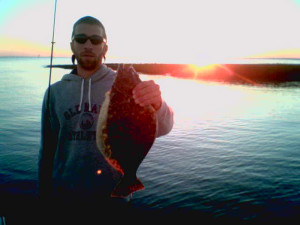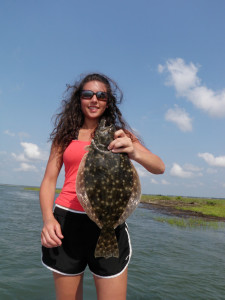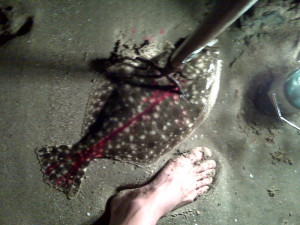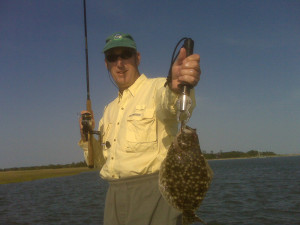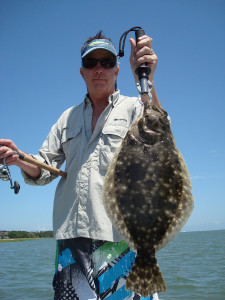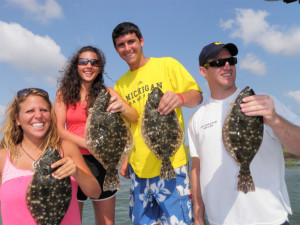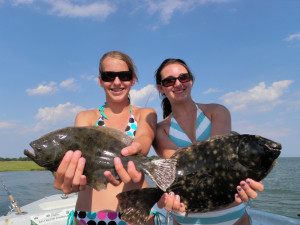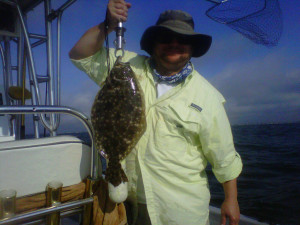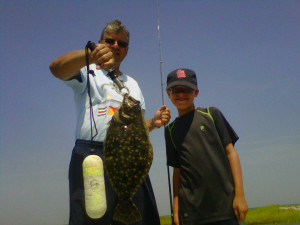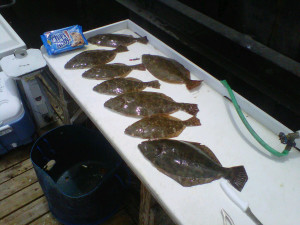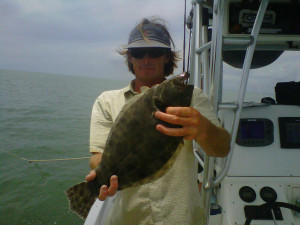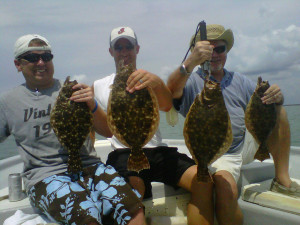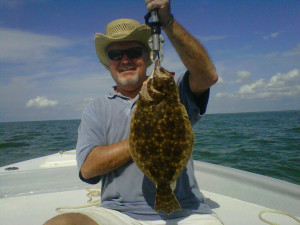Flounder Fishing Charters
April-November
Flounder is my favorite fish to catch hands down. It is not because they are strong fighters or that they jump and make long runs. They are rather lethargic fighters and are hard to target on rod and reel. Nevertheless, they are my favorite. The challenge lies in pinpointing their location and especially the hookset.
Flounder prefer to lie on the bottom and wait for the bait to come to them. They are able to change their skin color and spot pattern to mimic their surroundings. If a flounder is lying in wait for its prey over a broken shell bottom with dark and light colors they will mimic that environment by changing the color and frequency of the spots on their skin. Very often when you find flounder closer to the beach or out in the ocean over blank sandy bottom their markings are more drab and plain. When their prey comes along it is most likely unsuspecting and gets ambushed by this ultra camo flatfish.
As a young boy I was always told to give a slow count to 7 before I set the hook on a flounder. I spent a lot of time with my parents and siblings in the Cape Romain Wildlife Refuge fishing from the beach. Mom and Dad weren’t real keen on fishing from the boat with us kids so we always fished in the surf or on the backside of the beach near one of the many inlets up in “The Cape”. Casting a minnow and slowly retrieving it would often produce a flounder strike as long as you had enough persistence to spend some time fishing and subsequently the discipline to give the fish a 7 count once you got a bite. It is pretty easy to tell the difference between a “flattie” and other fish because most other fish will bite and immediately start to swim away. A flounder on the other hand tends to bite the bait and return to the bottom where it is most at home and savor the flavor before it swallows the bait. The bait most often being a mud minnow or small “finger mullet”. From my experience I confidently advise anglers to wait as long as they can stand it to set the hook if they think they have a flounder on the line. It seems to me that most often a flounder will bite the baitfish by the tail or half way up the body. They will then lay still on the bottom for a few or sometimes several seconds before they actually try to swallow their prey. On charters I most often use circle hooks which require a slow steady hookset so the best thing to do is to wait for up to 30 long seconds and then just start reeling. You should reel medium fast until the rod gets heavy and the line comes tight and then fight the flounder slow and steady to the boat where I will be waiting with the landing net.
A flounder has three ways to get away once you have him hooked. If you follow my advice for the three stages of fighting a flounder your chances of success will be much greater. These three stages all involve the flounder “throwing the hook”. Their mouth is very soft with an intricately designed jaw structure with loose delicate skin everywhere. If you put heavy pressure on a flounder while you are fighting it to the boat it will shake its head and rip the hook free and swim away. If this happens you will most often see your captain get very SAD. When you first hook a flounder it will most often feel like dead weight. Much like you are reeling in a wet plastic grocery bag. The flounder will most often maintain this composure until it gets close to the boat and subsequently close to the surface of the water. At this point the flounder tends to make one or two short runs. If you anticipate this and just let him do his thing the hook will stay buttoned up and the fight will continue. The angler should keep the rod tip low, minimizing pressure on the fish at all times and especially during the one or two runs. If the hook doesn’t pull loose at this point you only have two more obstacles to overcome. The next thing the flounder will do is come to the surface. You don’t want this to happen. If its head breaks the surface of the water the flounder will very often shake the hook. A flounder is able to shake its head faster than most other fish and will do so in a desperate effort to shake the hook loose. Especially if its head is above the surface of the water. This is another reason to keep the rod tip low and close to the water. If your rod tip is high (45 degrees or more) the fish is more likely to come to the surface. If the angler maintains light pressure during this stage of the fight then the chance of bringing the fish to the net are very good. Netting the fish is the final challenge. I have heard lots of stories from lots of fishermen about losing flounder right next to the boat. Most often this is because they had no landing net or were “high sticking” the fish. If the angler keeps the rod tip low and patiently brings the fish to the boat without its head breaking the surface of the water there is a very good chance that the captain will be able to net the fish without incident. I have seen flounder jump over, out of and swim under the net to try to elude capture. This is why I keep a really big landing net on board at all times. Tight lines and thanks for reading. Call, email or text and hopefully we can schedule a trip soon.

